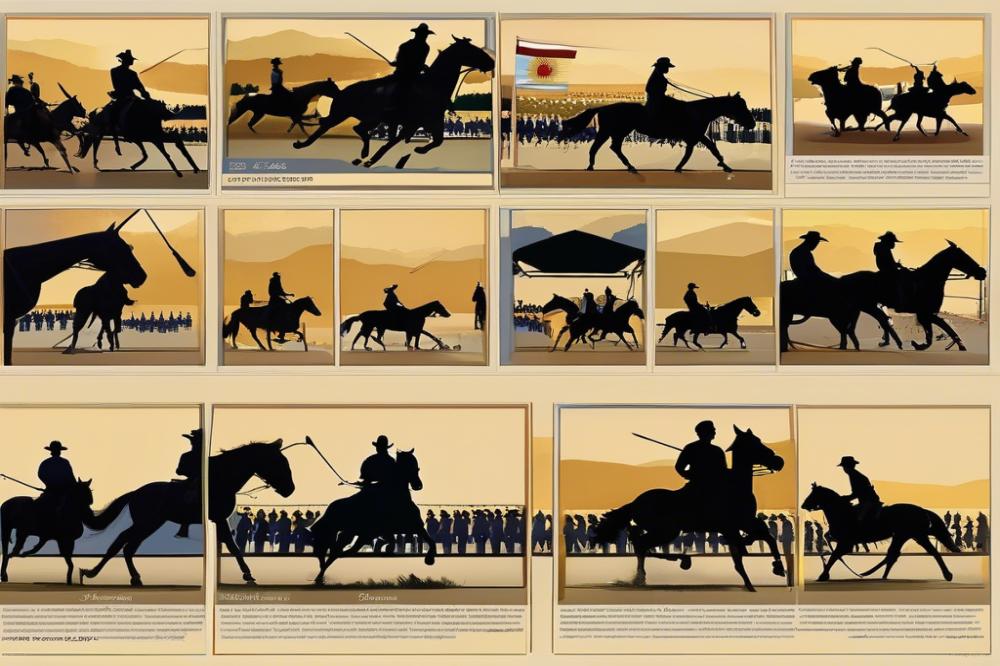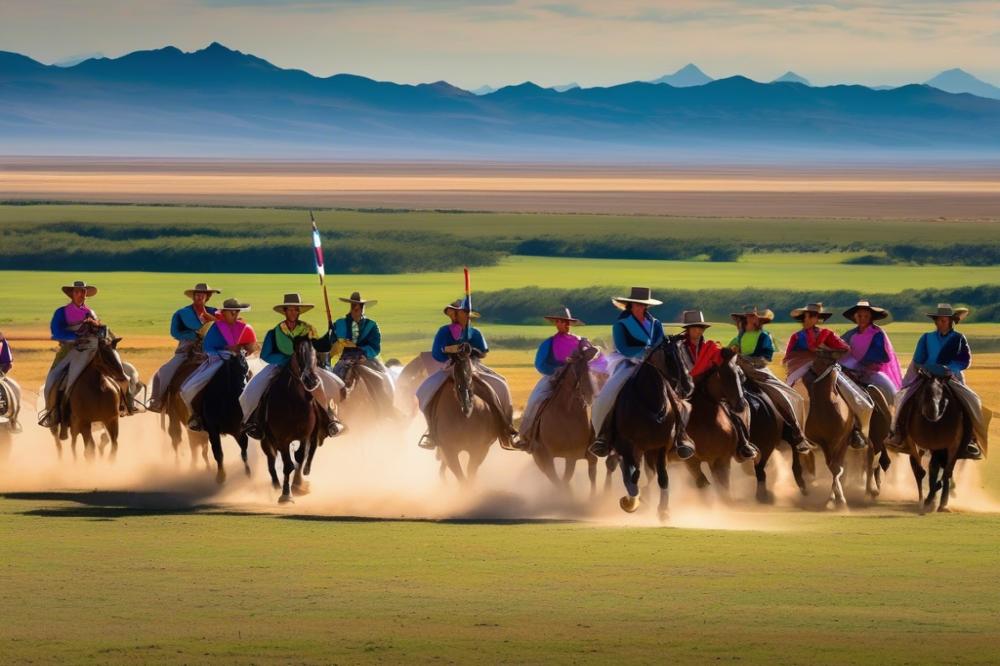Introduction
The horse population in horses-in-agriculture-and-culture”>Argentina has captivated many. With approximately 3.6 million horses, this country displays a rich connection to these animals across various aspects. Horses play a crucial role in agriculture, helping with farming and livestock management. Their presence in culture and sports is equally significant, showcasing the deep reliance on these creatures.
The gaucho tradition finds its essence in the bond between these skilled horsemen and their steeds. Historically, gauchos have relied on horses for daily tasks. They embody the spirit of freedom and the rugged landscapes of the vast plains. polo, a sport rooted in this equestrian relationship, highlights the beauty and athleticism of both horses and players. This connection is more than mere utility; it is a profound partnership that resonates through generations.
Understanding the importance of horses in Argentina means recognizing their impact on identity and heritage. For many, these animals symbolize loyalty, bravery, and tradition. The gaucho lifestyle embraces a philosophy where horse and rider move in unison, illustrating trust and skill. Such values not only enrich agricultural practices but also enhance cultural ceremonies and regional festivities.
As we delve deeper into the significance of these 3.6 million horses, their influence on polo and gaucho customs emerges more clearly. This exploration reveals how intertwined these elements are within the heart of Argentinian life.
The Horse Population in Argentina

The equestrian landscape in the country is marked by the presence of 3.6 million horses. This significant number highlights the central role horses play in sports and ranching. Equestrian activities, especially polo, have deep roots and cultural importance. They are more than just games; they symbolize tradition and mastery of horsemanship.
Each horse serves a purpose, whether in a thrilling match or assisting in everyday ranch duties. For many gauchos, horses are vital for managing livestock. Handling cattle becomes easier with a reliable horse by one’s side. This reliance on equine partners enhances productivity on ranches, proving how integral these animals are to agricultural practices.
Polo has gained global acclaim, but in the heart of rural life, horses do much more than entertain. They allow ranchers to navigate vast landscapes swiftly. Movement across fields is not just a physical need; it embodies a way of life deeply attached to the land. The connection between gauchos and their horses reflects mutual respect and understanding.
Horses also contribute to the local economy. Breeding, training, and selling these animals create jobs and empower communities. Many professionals emerge from these activities, ranging from trainers to veterinarians. This entire ecosystem relies heavily on equine involvement.
In essence, the horse population holds immense significance. Beyond numbers, horses shape daily routines and cultural expressions. Life in the countryside is woven with experiences that center around these remarkable creatures. Thus, they are treasured assets not only for their utility but for the bond formed between horse and rider.
The Gaucho Tradition

The gaucho stands as a powerful cultural symbol in Argentina. Often seen as a proud, free-spirited cowboy, this figure represents more than just a way of life. A gaucho’s identity is deeply intertwined with the art of horsemanship. Horses are not merely transportation; they are partners in daily routines. Livestock herding is a primary duty for gauchos. They rely on their horses to manage cattle across vast landscapes. The bond between a gaucho and their horse is unique and essential.
Traditional clothing also reflects the gaucho’s lifestyle. Many wear wide-brimmed hats, sharp spurs, and bombachas, which are baggy trousers. These garments are practical for riding and reflect a rugged elegance. A characteristic belt made of leather holds essential tools. Across the gaucho’s waist, one often finds a facón, a large knife used for various tasks. The equipment used by gauchos is functional. It tells a story of survival in a challenging environment.
Gauchos play a vital role in shaping cultural identity. Their influence can be seen in music, dance, and literature. Folk songs often celebrate their bravery, struggles, and everyday life. This rich tradition connects people to their heritage. Many festivals celebrate gaucho culture, drawing attention to their unique customs. Furthermore, horses are central to these festivities. Spectacles of equestrian skill highlight the intimate relationship between horse and rider.
As a cultural icon, the gaucho inspires pride in national heritage. There is a deep sense of nostalgia associated with this figure. People resonate with the values of independence and resilience. These traits form part of the Argentine spirit. The traditions surrounding gauchos elevate their importance beyond mere history. They remind current generations of their roots and the vast landscapes that shaped their ancestors.
Polo: The Sport of Kings
Polo has a rich history that dates back centuries. Originating in ancient Persia, the game traveled through different cultures before finding a vibrant home in South America. Over time, Argentina transformed itself into a powerhouse in the sport, showcasing skill and passion on the field.
Horses are vital to polo. The relationship between rider and mount is crucial in this game. Strength, agility, and training of the horse contribute significantly to a team’s success. Many athletes dedicate years to finding the perfect horse, often establishing deep bonds that resemble companionship. In polo, success often hinges on the abilities of both horse and player.
The sport is more than just competition; it symbolizes a way of life. In Argentina, polo reflects values like teamwork, respect, and tradition. Famous players have emerged from this culture, each adding to the rich tapestry of the game. Names like Adolfo Cambiaso and Nacho Figueras have become synonymous with excellence. Their contributions elevate the profile of polo across the globe.
Tournaments also play a crucial role in the sport. Events such as the Argentine Open capture the attention of fans worldwide. These competitions are grand occasions, showcasing the best talent. Players and teams from various regions compete fiercely, but they also embody the spirit of camaraderie and respect.
The presence of horses in gaucho traditions is evident. Gauchos view their horses as partners in work and sport. This connection extends to polo, enriching the experience both on and off the field. Through the centuries, the horse has become a symbol of freedom and skill in the Argentine landscape.
In recent years, the expansion of polo has captured a new audience. It is gaining popularity beyond its traditional roots. More players are taking up the sport, influenced by the legends who paved the way. The accessibility of training and resources has contributed to a growing interest from young athletes.
Horses in Argentine Wildlife and Heritage
Polo and gaucho traditions are deeply woven into the culture. Horses hold a significant place in the natural setting. The vast plains and pampas provide ample space for these animals to roam. Wild horses can often be seen running free, embodying the spirit of the country. They play a vital role in the ecosystem, contributing to the management of grasslands.
Heritage sites highlight this relationship between people and their horses. Think about the estancias, or ranches. These places offer visitors a glimpse into traditional practices. Gauchos, the skilled horsemen, have shaped the land with their ways. Many cultural festivals celebrate this bond every year. Events feature horse displays, showcasing the breeds that make up the equestrian landscape.
Wildlife conservation efforts also focus on protecting horse populations. By maintaining the natural habitats, local organizations promote biodiversity. Horses influence not only the cultural narrative but also ecological balance. Their presence affects plant growth and the habits of other species.
Exploring the Pampas reveals a landscape where horses are key players. Visitors can experience the rolling hills and open skies. In this setting, many stories of resilience and heritage come to life. There are museums dedicated to equestrian history, providing insight into the evolution of these breeds. Knowledgeable guides share the stories behind iconic horse training techniques.
For many, horses symbolize freedom and adventure. Their role in herding cattle and navigating the land is irreplaceable. Communities deeply cherish their horse-related festivals and traditions. Watching gauchos perform tricks and maneuvers on horseback is a captivating sight. This vibrant culture continues to attract tourists and horse enthusiasts alike.
In summary, horses contribute significantly to both wildlife and heritage. They are not just a mode of transport but a representation of identity. Respect for this animal echoes through generations. The landscapes and traditions surrounding them are essential for understanding the rich culture of the land.
Economic Impact of Horses in Argentina
The horse industry plays a crucial role in the economy. Breeding, training, and sports related to horses generate significant revenue. Many rural communities depend on these activities for their livelihoods. From skilled trainers to caretakers, a variety of jobs exist within this sector. The sheer number of horses illustrates their value to local economies.
Tourism also benefits greatly from the horse culture. Travelers flock to witness thrilling polo matches or join gaucho-themed experiences. These tourist activities bring in vital income for small towns and rural areas. Local businesses, including restaurants and shops, thrive on the visitors drawn by equestrian traditions. This creates a ripple effect, boosting many sectors of the economy.
Horse-related events attract international attention, enhancing Argentina’s profile on the global stage. Major polo tournaments draw spectators and participants from around the world. Local artisans selling handmade gear and crafts find a ready market among these visitors. The connection between horse sports and local culture enriches the overall experience of tourists.
The impact of horses goes beyond just direct economic benefits. They symbolize a rich heritage and contribute to a strong sense of identity in many regions. Festivals celebrating horse riding and competitions foster community spirit. Together, these activities strengthen social bonds and build pride within communities.
In summary, the role of horses in the economy is multifaceted. Their contribution reaches beyond mere financial figures. Sustainable practices and responsible breeding methods can further enhance this industry. As equestrian interests grow, the long-term benefits for local communities remain promising.
The Future of Horses in Argentine Culture
Current trends are reshaping equestrian traditions and horse populations in the region. Modernization plays a significant role in this evolution. Technology has transformed agriculture, often replacing traditional methods. Many ranches now use machines for tasks that once required horses. These changes have led to a decline in the number of working horses on farms.
Some younger generations are losing touch with gaucho traditions. Equestrian skills that were once essential are less often taught. Popular culture promotes urban lifestyles, and interest in horsemanship wanes among youth. Yet, a strong appreciation for equestrian sports, like polo, remains. These sports celebrate the bond between humans and horses, highlighting their importance in society.
Efforts are underway to preserve gaucho culture and its connection to horses. Festivals showcase traditional skills and promote the history of these proud riders. Communities recognize the need to maintain their heritage. In rural areas, some people still rely on horseback for transportation and livestock management. This serves as a reminder of the enduring relationship between people and their animals.
Climate change also poses a risk for horse populations. Changes in weather patterns affect grazing lands. Some ranchers struggle with feed supplies, pushing them to downsize their horse numbers. Sustainable practices could mitigate some challenges. Implementing smart management can help maintain horse health and their role in farming.
Innovation can coincide with tradition. Equestrian schools are embracing modern techniques while honoring the past. By blending old and new, they create a comprehensive approach to training. This strategy encourages respect for heritage while preparing riders for contemporary challenges.
In summary, the future of horses in this culture seems to hinge on balance. Embracing modernization while valuing traditions will be vital. Active engagement in practices and preservation efforts may help maintain the unique connection between horses and their human counterparts.
Final Thoughts
The significance of horses in Argentine culture, sports, and the economy cannot be overstated. These magnificent creatures are woven into the fabric of everyday life. They represent strength, tradition, and a deep connection to the land. In the world of polo, they play a vital role. With around 3.6 million horses in the country, their importance stretches far beyond mere transportation.
Gaucho traditions highlight the relationship between people and these animals. The gaucho, often seen as a symbol of freedom and rugged individualism, showcases the skills that have defined a way of life for generations. Through vast plains and challenging terrains, their bond with horses has fostered a unique cultural identity. This connection transcends sport and taps into a shared history, resonating with pride among the populace.
In recent years, efforts to promote and preserve these traditions have gained momentum. Communities are increasingly aware of the need to maintain this heritage. Supporting local equestrian events and visiting ranches can help keep these customs alive. Appreciating the role of horses enriches the understanding of a nation’s legacy.
As time marches on, the story of horses and their place in society should remain in focus. This relationship forms a crucial part of a broader narrative involving community and identity. The legacy of the gauchos has much to teach us about resilience and connection. Recognizing the enduring value of these traditions is essential for future generations. By caring for this heritage, everyone can contribute to a vibrant cultural landscape.



